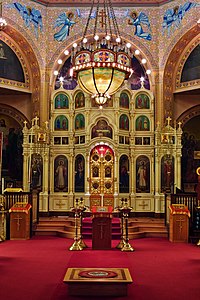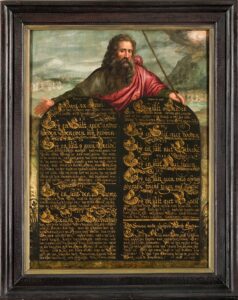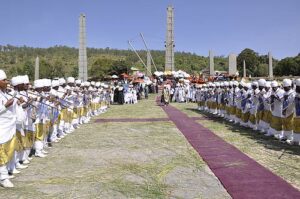Orthodox Tewahdo Church
History
We have been serving God in the Las Vegas, Nevada area since 2012. The Tigrayan Orthodox Tewahdo Church is one of the ancient churches established at the time of the Apostles. We are in the family of the Oriental Orthodox Churches. The Tigrayan nation was the first country in the world to accept Christianity as its national religion. Since the planting of the seeds of Christianity by the Apostles, our Faith has molded our history and culture.
This website provides up-to-date information on a myriad of topics, including the Tigrayan church’s history, belief, creed, worship, doctrine, literature, church music, and art. Take a glimpse of some of the many wonderful things that we are doing; we certainly are a church that is on the move for God! We welcome you to come and worship with us every Sunday morning and again on Friday evenings for our Bible Study. We look forward to seeing you again and Thank you for visiting the Debregenet MedhaneAlem Tigrayan Orthodox Tewahdo Church website. We are honored that you have taken the time to learn more about us. We are a Great Church with Great People, serving a Great God.

Our Orthodox Faith and Traditions
At Debregenet Medhanealem Tigrayan Orthodox Church, we are rooted in the ancient traditions of the Orthodox Tewahedo Church. We believe in the Holy Trinity, the divinity of Christ, the virgin birth, the resurrection of Christ, and the salvation of all humanity through the grace of God. Our worship services are conducted in Ge’ez, the ancient liturgical language of our church, and we offer English translations for those who may not be familiar with the language. We also have programs and ministries, including Sunday School and Bible studies, that reflect our beliefs and traditions, as well as community outreach projects that allow us to serve those in need. We are committed to preserving and sharing our rich heritage as Orthodox Christians with the world, and we invite you to join us in worship and service.
Pillars of Tigray Orthodox
Core Values

These are our core values
- Faith - We believe in the power of faith to guide and inspire our lives, and we are committed to sharing that faith with others.
- Love -We believe in the transformative power of love, and we seek to show love to our neighbors.
- Tradition -We honor the rich traditions of the Orthodox Church, and we are committed to preserving
- Service -We believe in the power of service to make a difference in the lives of others
What are the 5 pillars of Tigray Orthodox?
The Tigray Orthodox catechetical tradition, which has been developing since the 15th century, is expressed through “The Five Pillars of the Mystery” or “Amstu Aemade Mistrate.” The pillars include:
- The Holy Trinity
- Incarnation
- Baptism
- Eucharist.
- Resurrection

1. MYSTERY OF THE TRINITY:
In this section the mystery of Unity and Trinity of the Triune God is described. The Holy Trinity is three in name, in person (Akal), in deed and one in essence, in divinity, in existence, in will. Three in name: Father, Son Holy Spirit. Three in deed: the Father is the begetter, the Son is begotten, and the Holy Spirit is the one who proceeds. Three is person: the Father has a perfect person, the Son has a perfect person, and the Holy Spirit has a perfect person. The Father is the heart, the Son is the word, and the Holy Spirit is the life (breath). The Father is the heart for Himself, and He is the heart for the Son and of the Holy Spirit. The Son is the word for Himself, and He is the word for the Father, and for the Holy Spirit. The Holy Spirit is the life (breath) for Himself, and He is the life (breath) for the Father and the Son.
Even though we say the Trinity are three in name, in deed and in person; the three are one in essence, in divinity, in existence and in will; we do not mean three Gods but one God. While the Father and the Son and the Holy Spirit exist in their own perfect person, they are one in existence. (Abulidis, Faith of the Father’s Chap. 40 verse 4:6)
2. MYSTERY OF INCARNATION
Mystery of Incarnation means the mystery of the descending of God the Son who is one of the Trinity from heaven and taking up flesh and rational soul from the Holy Virgin Mary. This is the mystery of God becoming man and man becoming God “The Word became flesh and dwelt among us”. (Jn. 1:14).
3. MYSTERY OF BAPTISM
Baptism is the sacrament given to all who believe in the Mystery of the Trinity and the Mystery of Incarnation for the remission of sin, to obtain adoption from the Triune God, to inherit the kingdom of God. It is called mystery, because, when the priest recites the prayer of baptism over the water and blesses it, it will be changed and become the water that flowed from the right side of our Lord Jesus Christ and one can receive the invisible grace of the Adopted Son hood of God (Jn. 19:34-35).
4. MYSTERY OF HOLY COMMUNION
Mystery of the Holy Communion is a supreme act of life through which we can hold intimate communion with God and that which makes us one with God. “Verily, verily, I say unto you, except you eat the flesh of the Son of Man, and drink His blood, you have no life in you.” “Who so eat my flesh, and drink my blood will have eternal life. My flesh is meat in deed and my blood is drink indeed, for it is a real food. He/she that eat my flesh, and drink my blood, dwell in me, and I in her/him.” (Jn. 6:53-57).
5. MYSTERY OF THE RESURRECTION OF THE DEAD
Resurrection is the Mystery of life after death. All those who have departed from the time of Adam, and those who will pass away, until the Second Coming of Christ, will be raised in the union of body and soul. The souls of the righteous shall abide in paradise and the souls of sinners in hell until the end of this world. But on the last day, when our Lord and Savior Jesus Christ shall come in His glory, to judge the living and the dead, the souls shall be united with their bodies on the day of resurrection and they shall rise from the dust of the earth. (Luke 16: 29-31)
Our Orthodox Faith and Traditions
At Debregenet Medhanealem Tigrayan Orthodox Church, we are rooted in the ancient traditions of the Orthodox Tewahedo Church. We believe in the Holy Trinity, the divinity of Christ, the virgin birth, the resurrection of Christ, and the salvation of all humanity through the grace of God. Our worship services are conducted in Ge’ez, the ancient liturgical language of our church, and we offer English translations for those who may not be familiar with the language. We also have programs and ministries, including Sunday School and Bible studies, that reflect our beliefs and traditions, as well as community outreach projects that allow us to serve those in need. We are committed to preserving and sharing our rich heritage as Orthodox Christians with the world, and we invite you to join us in worship and service.
The Ark of the Covenant

According to the Book of Exodus, God instructed Moses to build the Ark during his 40-day stay upon Mount Sinai.He was shown the pattern for the tabernacle and furnishings of the Ark and told that it would be made of shittim wood (also known as acacia wood) to house the Tablets of Stone. Moses instructed Bezalel and Aholiab to construct the Ark.
The Book of Exodus gives detailed instructions on how the Ark is to be constructed. It is to be 2+1⁄2 cubits in length, 1+1⁄2 cubits breadth, and 1+1⁄2 cubits height (approximately 131×79×79 cm or 52×31×31 in) of acacia wood. Then it is to be gilded entirely with gold, and a crown or molding of gold is to be put around it. Four rings of gold are to be attached to its four corners, two on each side—and through these rings staves of shittim wood overlaid with gold for carrying the Ark are to be inserted; and these are not to be removed.A golden lid, the kapporet (translated as ‘mercy seat’ or ‘cover’), which is ornamented with two golden cherubim, is to be placed above the Ark. Missing from the account are instructions concerning the thickness of the mercy seat and details about the cherubim other than that the cover be beaten out over the ends of the Ark and that they form the space where God will appear. The Ark is finally to be placed under a veil to conceal it.(wiki)
According to Tigrayan tradition, the Ark of the Covenant is preserved in the ancient holy city of Aksum. For centuries, the great relic was kept in the Church of Mary of Zion, where the emperor Iyasu is recorded as having seen it and spoken to it in 1691. Now it is kept in the Chapel of the Tablet, which was built beside the church during the reign of the last emperor Haile Selassie. The relic is entrusted to a single guardian, who burns incense before it and recites the Biblical Book of Psalms. No one else can approach it, including the high priest of Aksum. The guardian is not only a monk, but a virgin as well, and he serves the Ark until he appoints a successor as his own death approaches.
The classic account of the Ark in Tigray is found in a medieval epic written in Geez, The Glory of Kings. It describes how the Queen of Sheba had heard that King Solomon possessed great wisdom, and traveled to Jerusalem so that she could learn to govern her own people more wisely. When she arrived, Solomon was impressed by her intelligence as well as her beauty. He began to hope that he might have a child by her, although the epic is anxious to tell its readers that the king was not driven by lust, but by a plan to fill the earth with sons who would be serve the God of Israel. The queen did conceive a son, and after he had grown he set out from Tigray to visit his father. Solomon anointed him as king of Tigray, and then instructed the elders of Israel to send their own sons to Africa to serve him as counselors. Because the young Israelites were desperately unhappy that they would never see Jerusalem and its Temple again, they decided to carry the Ark with them. In fact, The Glory of Kings tells us that the Ark itself had decided to leave Jerusalem because the Jews had abandoned the faith that God had revealed to them. (By Roderick Grierso)
Timket/Epiphany

Timket is an Orthodox Tewahedo
Church celebration of Epiphany. It is celebrated on 19 January (or 20 in a leap
year), corresponding to the 11th day of Terr in the Ge’ez calendar.
Timkat celebrates the baptism of Jesus in the River Jordan. This festival is best known for its ritual reenactment of baptism (similar to such reenactments performed by numerous Christian the Holy Land when they visit the Jordan).
During the ceremonies of Timkat, the Tabot, a model of the Ark of the Covenant, which is present on every Tigrayan altar (somewhat like the Western altar stone), is reverently wrapped in rich cloth and borne in procession on the head of the priest. The Tabot, which is otherwise rarely seen by the laity, represents the manifestation of Jesus as the Messiah when he came to the Jordan for baptism. The Divine Liturgy is celebrated near a stream or pool. Then the nearby body of water is blessed towards dawn and sprinkled on the participants, some of whom enter the water and immerse themselves, symbolically renewing their baptismal vows.
Know your religion !

Learn every week by trying the quizzes posted here.
Books
- Ten Comandments
- Daily Prayer-Tselot zezewetr
- HYMN OF PRAISE - Wudase Maryam (coming soon)
